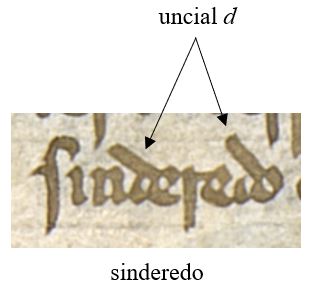The hand used in manuscript C of Alfonso X’s Estoria de España is a Gothic book hand. This was derived from the previous hand, the Caroline, and the habit of the scribes to make a beveled cut into the nib, towards the left. The Gothic hand is characterised by its quite uniform square form, slightly higher than it is wide, with ascenders and descenders that are elongated, but not excessively so, and which are almost always vertical, with the exceptions of d, g, and y, in which straight forms and uncial forms towards the left alternate.
The use of abbreviated forms in this type of writing is not very numerous in the most careful manuscripts, but regular. The abbreviation marks most frequently used, and which tend to appear above the word, are the macron, of which the length varies, and the vowels a, i o, and u which appear in a small form.
The ç appears as often before an a or an o (fuerça, arçobispo) as it does before an e or an i (arçediano, çibdat).
As can be seen, rounded letters predominate over angular ones, so the letters i and u are more numerous than j and v, such as leuaua<n>, touiesen or arauigo; however, a certain multifunctionality of some letters can be seen, where letters can be used as both consonants and vowels, such as u which can be used in uida and fuerça or v, as in vsasen and visq<ui>esen.
Having said that, in this manuscript j is used as a vowel as often as it is used as a consonant, such as in cl<er>jgos or tenje<n>do, whilst i is only used as a vowel, and not as a letter with both vowel and consonant values, as happened in the Auto de los Reyes Magos.
The letter y appears in word-initial position with a consonantal value in yaze and with a vocalic value in ysidro; and word-centrally with a vocalic value, as the second element of a dipthong, in destruymjento or ley, and with a consonantal value in mayor or pelayo.
Another characteristic of this hand is the use of the Tironian sign, which we are transcribing as e, for the conjunction.
Moreover, we would like to comment on certain aspects regarding the vowels, which are characteristic of the written tradition of thirteenth-century Castilian, and which also appear in the Estoria de Espanna. We can perceive wavering in the vowels e ~ i in eglesias for iglesias, bevir for vivir, or clerjzia for clerezia; in a ~ e in perrochias for parrochias; and in the velar vowels o ~ u in logar for lugar or touiesen for tuviesen. As we can observe, unstressed vowel system reflects a clear hesitation due to the greater weakness of the phonic context: lacking the intensity of the accent, it undergoes more changes than the stressed vowels.
As for the dipthongisation of the Latin short stressed Ŏ into ue, a wavering between o and ue was usual in the second half of the thirteenth century, but in this fragment of the Estoria de España, copied in the first decades of the fourteenth century, only the dipthongised forms appear: fuerça (< FŎRTIA), buena (< BŎNA) and nuestra (< NŎSTRA).
Rocío Díaz Moreno
Biography
Rocío Díaz Moreno is a doctor in Hispanic Philology and lecturer at the University of Alcalá. As a researcher, she has participated in national projects dedicated to the study of Castilian documents from the Middle Ages and from the 16th to the 19th centuries and to the study of sociolinguistic patterns in the Community of Madrid. She currently works on several projects: CODEA+2020, ALDICAM (Diachronic and Interactive Linguistic Atlas of the Community of Madrid) and ESCONES (Spanish Corpus in School Contexts, GIELEN Group). She belongs to the “Grupo de Investigación Textos para la Historia del Español” (GITHE), coordinated by Pedro Sánchez-Prieto Borja, and she is a member of the CHARTA International Network (Corpus Hispánico y Americano en la Red. Textos Antiguos).







